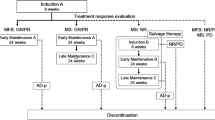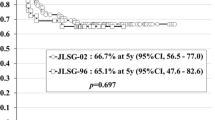Abstract
The JLSG-96 study reported very low mortality rates for children newly diagnosed with multifocal Langerhans cell histiocytosis (LCH). The JLSG-02 study was performed to further improve the prognosis from 2002 to 2009. The present study compared the therapeutic results of these two studies in terms of multisystem disease. All patients were treated with 6 weeks of the Induction A regimen, comprising cytarabine, vincristine and prednisolone, followed by maintenance therapy. Poor responders to Induction A were switched to Induction B. JLSG-02 has been revised from JLSG-96 in the following respects: prednisolone dosage during Induction A increased; duration of maintenance therapy extended from 24 to 48 weeks; cyclosporine introduced to Induction B for progressive disease. One hundred forty-seven children with multisystem LCH were evaluated. Of these, 84 were positive for risk of organ involvement (RO) and 63 were RO-negative. At the 6-week point, 76.2 % of RO+ and 93.7 % of RO− patients responded to Induction A. Five-year event-free survival (EFS) was 46.2 % [95 % confidence (CI), 35.5–56.9] for RO+ and 69.7 % (58.4–81.1) for RO−, which was significantly superior to that in JLSG-96 [26.8 % (13.3–40.4) and 38.9 % (16.4–61.4), respectively]. The intensified induction and prolonged maintenance regimens in JLSG-02 improved EFS in patients with multisystem LCH.



Similar content being viewed by others
References
Morimoto A, Oh Y, Shioda Y, Kudo K, Imamura T. Recent advances in Langerhans cell histiocytosis. Pediatr Int. 2014;56:451–61.
Morimoto A, Ishida Y, Suzuki N, Ohga S, Shioda Y, Okimoto Y, et al. Nationwide survey of single-system single site Langerhans cell histiocytosis in Japan. Pediatr Blood Cancer. 2010;54:98–102.
Titgemeyer C, Grois N, Minkov M, Flucher-Wolfram B, Gatterer-Menz I, Gadner H. Pattern and course of single-system disease in Langerhans cell histiocytosis data from the DAL-HX 83- and 90-study. Med Pediatr Oncol. 2001;37:108–14.
Minkov M, Grois N, Heitger A, Pötschger U, Westermeier T, Gadner H. Treatment of multisystem Langerhans cell histiocytosis. Results of the DAL-HX 83 and DAL-HX 90 studies. DAL-HX Study Group. Klin Padiatr. 2000;212:139–44.
Morimoto A, Kobayashi R, Maeda M, Asami K, Bessho F, Imashuku S. Impact of reactivation on the sequelae of multi-system Langerhans cell histiocytosis patients. Pediatr Blood Cancer. 2008;50:931–2.
Minkov M, Steiner M, Pötschger U, Aricò M, Braier J, Donadieu J, et al. Reactivations in multisystem Langerhans cell histiocytosis: data of the international LCH registry. J Pediatr. 2008;153:700–5.
Gadner H, Grois N, Arico M, Broadbent V, Ceci A, Jakobson A, et al. A randomized trial of treatment for multisystem Langerhans’ cell histiocytosis. J Pediatr. 2001;138:728–34.
Gadner H, Grois N, Pötschger U, Minkov M, Aricò M, Braier J, et al. Improved outcome in multisystem Langerhans cell histiocytosis is associated with therapy intensification. Blood. 2008;111:2556–62.
Gadner H, Minkov M, Grois N, Pötschger U, Thiem E, Aricò M, et al. Therapy prolongation improves outcome in multisystem Langerhans cell histiocytosis. Blood. 2013;121:5006–14.
Morimoto A, Ikushima S, Kinugawa N, Ishii E, Kohdera U, Sako M, et al. Improved outcome in the treatment of pediatric multifocal Langerhans cell histiocytosis: results from the Japan Langerhans Cell Histiocytosis Study Group-96 protocol study. Cancer. 2006;107:613–9.
Ronceray L, Pötschger U, Janka G, Gadner H, Minkov M. Pulmonary involvement in pediatric-onset multisystem Langerhans cell histiocytosis: effect on course and outcome. J Pediatr. 2012;161:129–33 e1–3.
Minkov M, Grois N, Broadbent V, Ceci A, Jakobson A, Ladisch S. Cyclosporine A therapy for multisystem langerhans cell histiocytosis. Med Pediatr Oncol. 1999;33:482–5.
Kong LR, Huang CF, Hakimian D, Variakojis D, Klein L, Kuzel TM, Gordon LI, Zanzig C, Wollins E, Tallman MS. Long term follow-up and late complications of 2-chlorodeoxyadenosine in previously treated, advanced, indolent non-Hodgkin’s lymphoma. Cancer. 1998;82:957–64.
Donadieu J, Bernard F, van Noesel M, Barkaoui M, Bardet O, Mura R, et al. Cladribine and cytarabine in refractory multisystem Langerhans cell histiocytosis: results of an international phase 2 study. Blood. 2015;126:1415–23.
Kudo K, Ohga S, Morimoto A, Ishida Y, Suzuki N, Hasegawa D, et al. Improved outcome of refractory Langerhans cell histiocytosis in children with hematopoietic stem cell transplantation in Japan. Bone Marrow Transplant. 2010;45:901–6.
Veys PA, Nanduri V, Baker KS, He W, Bandini G, Biondi A, et al. Haematopoietic stem cell transplantation for refractory Langerhans cell histiocytosis: outcome by intensity of conditioning. Br J Haematol. 2015;169:711–8.
Badalian-Very G, Vergilio JA, Degar BA, MacConaill LE, Brandner B, Calicchio ML, et al. Recurrent BRAF mutations in Langerhans cell histiocytosis. Blood. 2010;116:1919–23.
Chakraborty R, Hampton OA, Shen X, Simko SJ, Shih A, Abhyankar H, et al. Mutually exclusive recurrent somatic mutations in MAP2K1 and BRAF support a central role for ERK activation in LCH pathogenesis. Blood. 2014;124:3007–15.
Brown NA, Furtado LV, Betz BL, Kiel MJ, Weigelin HC, Lim MS, et al. High prevalence of somatic MAP2K1 mutations in BRAF V600E-negative Langerhans cell histiocytosis. Blood. 2014;124:1655–8.
Héritier S, Jehanne M, Leverger G, Emile JF, Alvarez JC, Haroche J, et al. Vemurafenib Use in an Infant for High-Risk Langerhans Cell Histiocytosis. JAMA Oncol. 2015;1:836–8.
Acknowledgments
The authors thank the many physicians who participated in the JLSG-02 study. We also thank Ms Yasuko Hashimoto for secretarial assistance. This work was supported by a Grant for Research on Measures for Intractable Diseases from the Ministry of Health, Labor and Welfare, Japan (Grant Reference Number: H24-General-076).
Author information
Authors and Affiliations
Corresponding author
Ethics declarations
Conflict of interest
The authors have no conflicts of interest to declare.
Additional information
On behalf of the Japan LCH Study Group.
About this article
Cite this article
Morimoto, A., Shioda, Y., Imamura, T. et al. Intensified and prolonged therapy comprising cytarabine, vincristine and prednisolone improves outcome in patients with multisystem Langerhans cell histiocytosis: results of the Japan Langerhans Cell Histiocytosis Study Group-02 Protocol Study. Int J Hematol 104, 99–109 (2016). https://doi.org/10.1007/s12185-016-1993-3
Received:
Revised:
Accepted:
Published:
Issue Date:
DOI: https://doi.org/10.1007/s12185-016-1993-3




